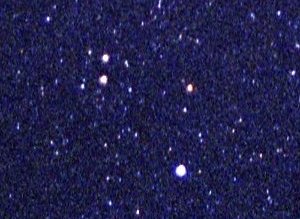 The Little Kids. North is to the left. Theta Aurigae, near
bottom center, leads the eye upward to the thin triangle of stars
we might call "The Little Kids," made (clockwise from lower left)
of Nu,
Tau, and Upsilon Aurigae. The figure is remarkably similar
(though reversed) to the classic "Kids" near Capella, made of Epsilon, Zeta,
and Eta Aurigae. The coolest of the trio,
Upsilon takes on a slightly reddish cast.
The Little Kids. North is to the left. Theta Aurigae, near
bottom center, leads the eye upward to the thin triangle of stars
we might call "The Little Kids," made (clockwise from lower left)
of Nu,
Tau, and Upsilon Aurigae. The figure is remarkably similar
(though reversed) to the classic "Kids" near Capella, made of Epsilon, Zeta,
and Eta Aurigae. The coolest of the trio,
Upsilon takes on a slightly reddish cast.